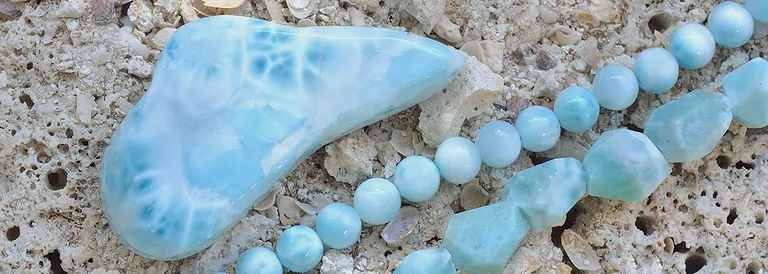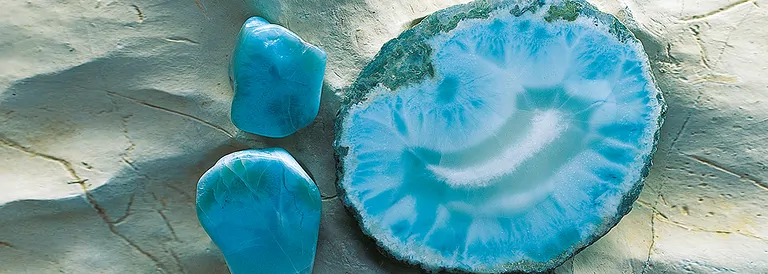
Larimar - Meaning and Effect
The bright blue Larimar inspires not only by its color, which fits wonderfully to light tanned skin, but also by its energy. Use the momentum and the power of the Larimar for the realization of your plans and wishes! Especially for the first steps of a new venture, the beginning of a project, the blue stone from the Caribbean is a good helper. Start with Larimar your project!
The blue Larimar brings us inner calm and helps, if necessary, out of a phase of withdrawal and stagnation. Mental growth and creative action are supported. Especially at the beginning of a project, this stone can help to take your life energetically in hand, to actively shape your own being. Openness to impressions from all directions leads to new ideas and perspectives.
Larimar, the blue gemstone of the Caribbean, is called pectolite in mineralogy. Thanks to good contacts and shareholdings in the mine in the only area in the Dominican Republic where this stone is found, we can offer you this otherwise very expensive stone at a favourable price. Most of the rough stones are processed in our own cutting shop in Haifeng. This gives us control over the entire production process. I In our wholesale assortment, we carry Larimar in various forms, for example, as Tumbled Stones, stranded goods for jewelry making, but also as drilled cabochons and Larimar jewelry.
Bracelets, pendants, rings and more Larimar jewelry for shops and retailers
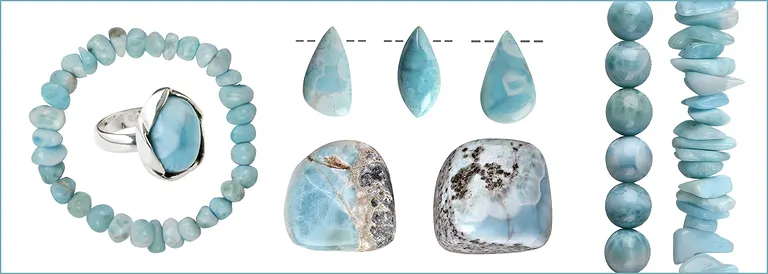
Origin of the name Larimar and synonyms
The name "Larimar" is composed of the maiden name "Lari" and the Spanish word "Mar" for "sea". The stone has been known by this name since 1975, when Miguel Mendez, owner of a Larimar mine/expert in handicrafts in the Dominican Republic, invented it and thus made the name of his daughter Larissa known worldwide.
Before this time, Larimar was also called Travelina, but the Larimar is far better known under its esoteric name Atlantis stone, since according to legend, part of Atlantis was located on the territory of the present Dominican Republic. Jewelers, goldsmiths, and jewelry designers also like to refer to the Larimar as the "Gemstone of the Caribbean." Mineralogical databases list the Larimar as a light blue variety of pectolite.
Eggs, spheres, massage stones, tumbles stones from our own fabrication for dealers and retailer
Mineralogical profile of Larimar
Chemical Formula: Ca2Na(HSi3O9
Mineral Class: Chain Silicate
Origin: hydrothermal fissure filling in druses and fissures of a weathered basalt
Color: White to light blue
Hot fluids dissolve the copper sulfide chalcocite (Cu2S) present in basalt, giving Larimar its blue color.
Gloss: Glass, Mother of Pearl to silk luster
Crystal system: triclinic
Moh hardness: 4.5 to 5.0
Splitability: perfect splitability
Appearance: Dense fibrous or radially radiating aggregates
The mineral Larimar does not form visible crystals, but dense aggregates in elongated cylinders (so-called "tubes") or nodules of a few millimeters to no more than 10cm in diameter. When cutting through the cylinders, the radial structure from the inside to the outside to the gray-brown crust and the fibrous structure can often be easily seen.
Colour of Larimar
Characteristic of the stone from the Caribbean is its white to light blue color; the more blue is found in a stone, the more valuable it is. Color-giving trace element is Copper or Vanadium. Light bands in Larimar can also be Natrolite, gray flecks Calcite. Dark to black inclusions consist of chalcocite (copper luster). Also typical are the wine-red inclusions of Hematite, which sometimes look like a small tree in the Larimar.
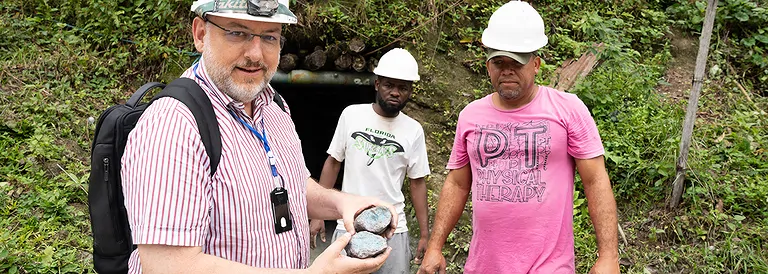
Resources, main supplier countries of Larimar
Larimar is found almost exclusively in the Dominican Republic. The mines are located near Baoruco in the province of Barahona in the southwest. The second locality "Fittà" near Soave in Italy is much smaller and the stones also do not have the intense bright blue of the Caribbean relatives, so that Larimar from Italy is only of interest to collectors, but is not processed into Larimar jewelry.
Use of Larimar
Only since the mid-1990s Larimar is known to a larger circle of people and has found its way into modern stone medicine. From its place of discovery in the Dominican Republic, no traditions for the use as a healing stone are known.
The astrology uses Larimar for Pisces-born to strengthen self-confidence and for the ability to set limits.
Larimar is very difficult to grind due to its mineralogical nature, because the fibrousness of the material many stones already break in the first processing step. From 1kg of rough stones you usually get only about 100 grams of cabochons, which can then be further processed into larimar jewelry. Larimar is especially popular as silver jewelry, since this precious metal brings out the color of the gemstone particularly well. Whether as Earstud, necklace or ring - the "Gemstone of the Caribbean" Larimar is often bought as a gift.
Fantastic wholesale prices: donuts, focale components, stringed beads and more Larimar items
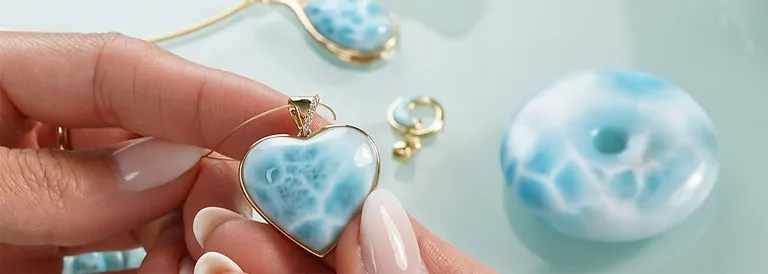
Larimar and gemstone healing
Larimar is the ideal healing stone when it comes to taking life into one's own hands and overcoming a passive basic attitude from which one easily feels victimized. The realization that the limits of the mind are only those we believe in and set for ourselves is strengthened by the Larimar; the stone conveys the feeling of (mental) expansiveness and supports (spiritual) growth. Openness becomes possible, but also the demarcation to the outside becomes easier.
With its help, negative things can be overcome; it brings calm and serenity, especially in dramatic changes and big emotions. Absorbed impressions can be better processed. Through the blue Larimar can promote goal-oriented thinking and creative action. Circumstances that can not be influenced or changed are more easily accepted, a different perspective helps to more serenity.
Larimar is a classic stone for meditation. As a slice or sawn open tuber, its contemplation can convey serenity, helping to calm and turn the gaze inward. Also laid as a stone circle, Larimar can be used for meditation. Placed on the forehead, chest or solar plexus, the stone from the Dominican Republic can dissolve energetic blockages and expand the ability to perceive. Gemstone Water with Larimar has a powerful effect; all common methods are suitable for its preparation.

Larimar is the blue variety of the mineral Pectolite and therefore has some close "relatives". Pectolite is found in more than 3000 different places, in Germany for example in the Black Forest and in the Sauerland. However, the stones found there are colorless, white, grayish white, yellowish or pink - no other pectolite has such a unique blue color as Larimar.
Due to its unusual color, radial structure and fibrous structure, there is little possibility of confusion with other minerals. Externally similar may be bright Turquoise, colored Magnesite (Turquenite), blue Calcite and Aragonite, but all are much softer than Larimar. Since genuine Larimar is one of the more expensive stones due to its rarity, imitations of light blue Glass or colored Magnesite are occasionally found, but are usually very uniform in color and pattern.

November 22 - Larimar day!
Over 100 years ago, on November 22, 1916, the very first Larimar was discovered in the Dominican Republic. As far as we know today, the bright blue gemstone was discovered by Father Miguel Domingo Fuertes de Loren from the community of Barahona, who was immediately fascinated by its unique color and named his discovery Travelina. However, the application to mine the mineral commercially was rejected and the stone was forgotten for many decades.
In 1976, artisan Miguel Mende came across information about this rare gemstone, which is only found in the Dominican Republic, and set out to find it. This marked the beginning of the triumphant advance of the blue mineral, which has since been treasured by gemstone and jewelry lovers all over the world under the name Larimar.
In the Dominican Republic, National Larimar Day has been celebrated on November 22 since 2018. Three special features of the stone are highlighted: the only place where it is found in the Dominican Republic, the country's cultural heritage and the unique beauty of the gemstone.
